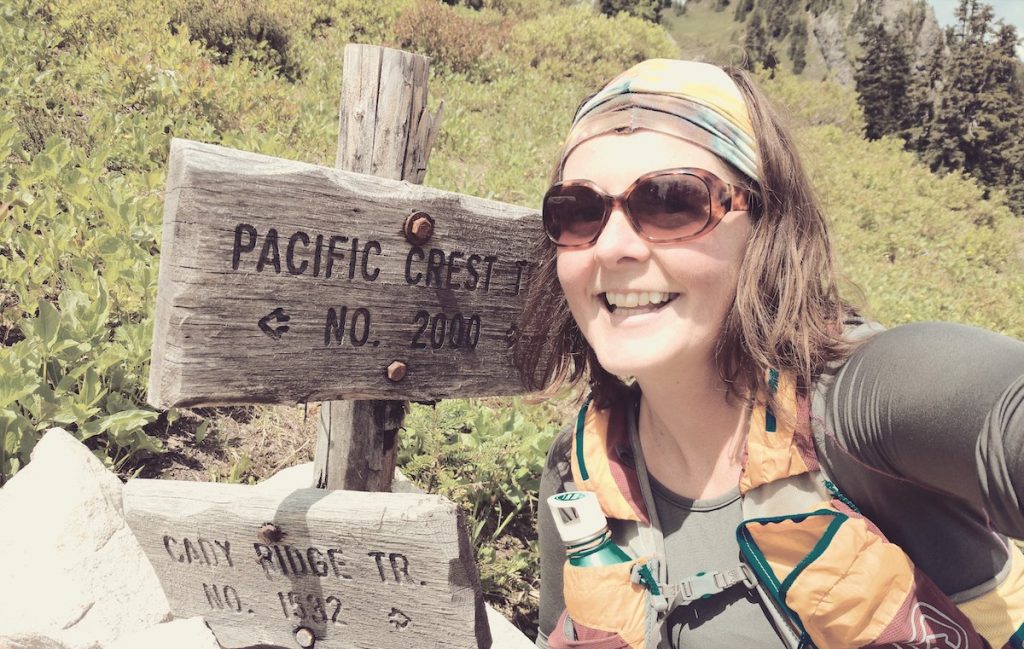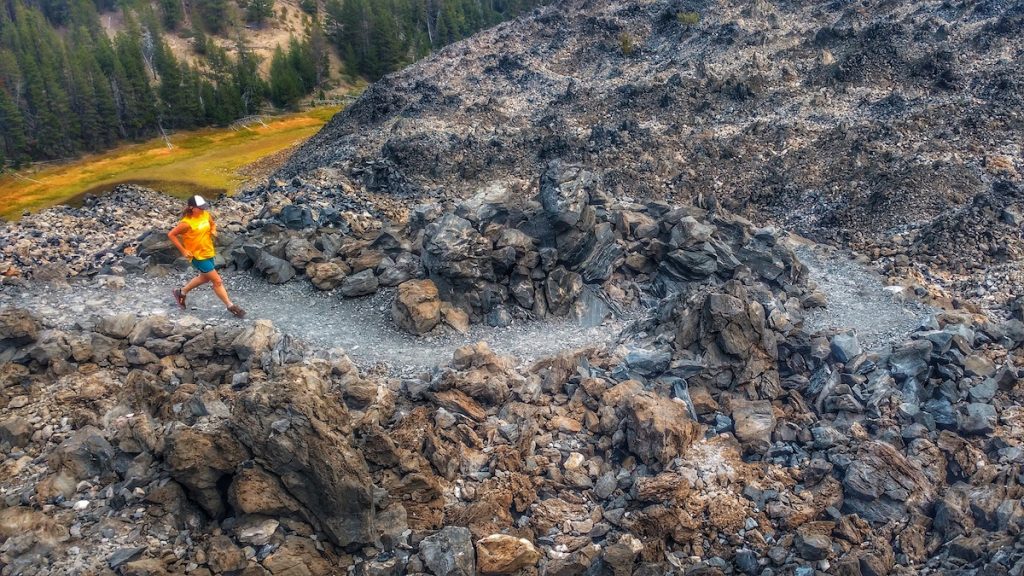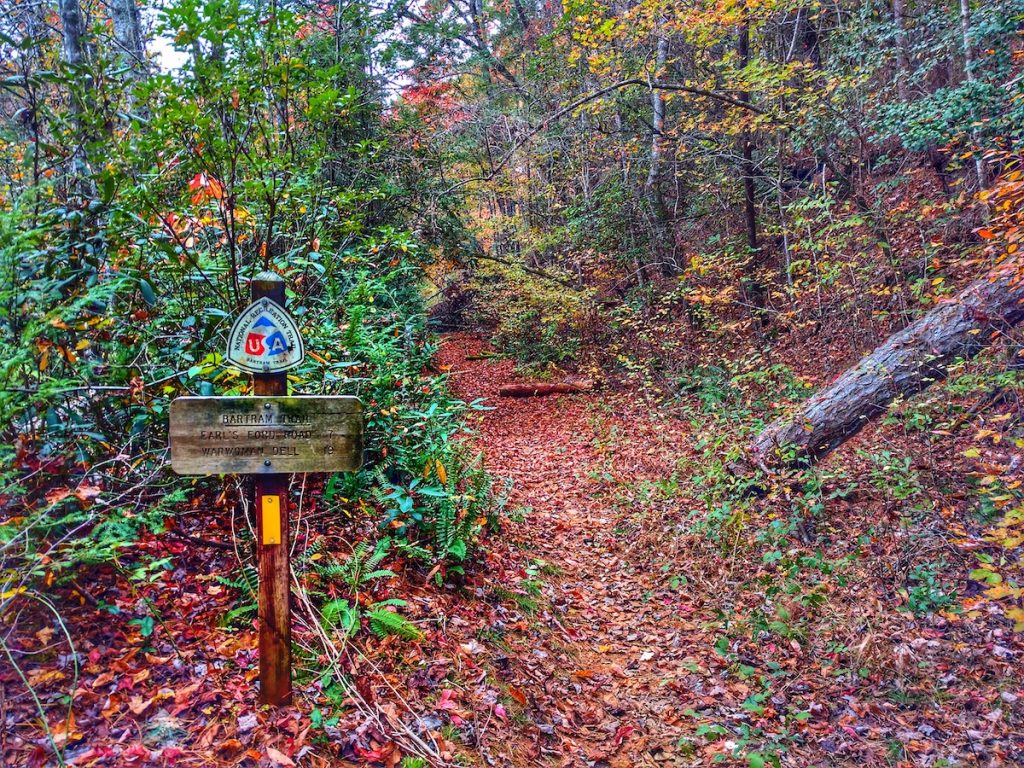Main Menu
Homepage / Words from the Wild / How to Transition from Hiking to Trail Running
How to Transition from Hiking to Trail Running

Heather Anderson is a National Geographic Adventurer of the Year, three-time Triple Crown thru-hiker, and professional speaker whose mission is to inspire others to “Dream Big, Be Courageous.” She is also the author of two hiking memoirs Thirst: 2600 Miles to Home and Mud, Rocks, Blazes: Letting Go on the Appalachian Trail and a preparatory guide to long-distance hiking Adventure Ready. Find her on Instagram @_WordsFromTheWild_ or her website wordsfromthewild.net
Share This Article!


By: Heather Anderson
“I just finished my thru-hike of the Appalachian Trail so I signed up to run a marathon in two weeks. If I can hike 26 miles in a day with a backpack, I can definitely run it without.”
Same person two weeks later:
“I ran the first 13 miles, but I had to walk the rest. It hurt so much and I have shin splints now. I’m hobbling.”
I’ve seen and heard this exact story over and over. It seems like solid logic, right? To some extent, yes, but not exactly. As a thru-hiker, ultrarunner, and personal trainer I have some insight into this transition from hiking to running (and vice versa) and how to do so without injury.
Same Systems; Different Functions
The reason so many thru-hikers think they can run a marathon right after hiking 2,000 miles is because of a very straightforward logic: running and walking use the same muscles and cardiovascular system. While this is true, these two movements use those systems in different ways. I’m assuming since you’re here on Trail Sisters you already hike or run on trails. Think about how it felt when you first switched from running or walking on sidewalks or paved bike paths to single track (or how you feel when you can’t get on the trails and you end up covering 5k on pavement). Different right? Probably different parts of you are sore afterward (or even during). Same systems, same motion, different surface. These differences matter.
You’re using your feet and quads and glutes and calves to propel yourself down the trail whether walking or hiking. These muscles work in concert to get you where you need to go. Your heart and lungs cycle the oxygenated blood through those working parts at the rate necessary to turn over the spent red blood cells and refresh the tissues with oxygen. But think about how your muscles move when you shift gears between running and walking (go ahead and give it a try right now for a few yards).
If you got up and played with your gait just now you probably felt strong contractions in your glutes and hip flexors as you shifted into a run. You probably noticed more activity in your quad when you slowed to a walk. Even your biceps became more engaged when you ran. You might have noticed how much more air you needed to inhale (and exhale) as well when you ran. You were using all the same parts each time, but in different ways.
Running is more than faster walking. Walking is more than slower running. They are separate gaits/activities that utilize the muscles and systems of the body in different ways.
Speed Matters
Running is faster than walking. This matters when it comes to the way the systems function. As I mentioned above, you probably noticed stronger contractions in different muscle groups when you switched between the gaits. This means if you’re well adapted to hiking, your hip flexors may not be properly conditioned for the rapid, strong contractions necessary to lift your leg up higher and swing it forward when you run. The same goes for the glutes. Which is why you see so many people slow to a shuffle in the later stages of a long run. Their musculature can no longer rapidly respond. The faster you move, the less recovery time each muscle (joint, tendon, etc.) has in between movements. This leads to fatigue at a much faster rate. Perhaps you can hike 26 miles over a 12-hour hiking day, but when you ask those muscles to move you that same distance in 4-6 hours, they are likely going to tire out partway through.

A strong, competent hiker has an excellent base of fitness that can translate to trail running with proper conditioning to the intensity of the activity. You may be able to “go all day” at a walking pace, but this will likely translate to only an hour or two initially when you switch to running.
Impact
Related to speed, impact is something else to consider when transitioning between hiking and trail running. The amount and distribution of force varies. The impact forces in running are significantly more than in walking. This increased impact affects your feet, ankles, knees, leg muscles, and back. It’s essential to progress into running—especially on trails—slowly to allow your body time to adapt to the higher impact loads so you can avoid injury.
A note for trail runners looking to experiment with backpacking: impact forces apply to you too. If you’re used to running down the trail with little to no weight on your back then be aware that putting on a twenty-pound backpack is going to put an unusual amount of impact on your joints, back, hips, legs and shoulders, in addition, it will compromise your balance. While the impact will feel different than running; it will similarly affect your body and can lead to injury if adequate adaptation time is not given.
The higher impact forces of running can lead to injury if you do not allow your body to adapt slowly. Avoid trying to go too far or too fast, too soon.
Making the Transition
Baby Steps
Going back to our example thru-hiker, it can be demoralizing to feel like you are in invincible shape and then not be able to run a marathon. I’ve also seen fast, accomplished trail runners crushed by 20 miles with a backpack on. The key to this is to remember that sport specificity is real and it matters. When you look to transition from hiking to trail running (or vice versa) you’ll need to take baby steps before you take leaps and bounds.
If you are a strong hiker you probably have excellent musculature and bone density as well as hiking skill that will translate seamlessly into trail running with the proper training. The key is to hit the trail for a run and don’t be afraid to walk. In trail running (especially longer distances) hiking ability is actually a superpower! Trails are often too technical or steep to run effectively. Being able to hike efficiently on that terrain will keep you moving forward consistently. Don’t try to run things that aren’t runnable for you. Walking during a trail run isn’t a sign of weakness; it’s a valuable technique. Even the most elite trail runners utilize hiking to get through the toughest stretches.
A classic style of training run is the fartlek (Swedish for “speed play”) or continual interval training. When you start trail running, you’ll most likely find yourself doing fartlek training by default. When you get tired, hike. When you’re breathing evens out, run again. The good news is that this is the type of training many runners use to get stronger and faster. Keep at it and you’ll find that the hiking breaks grow shorter over time.
Hiking and trail running go hand in hand. Over time you’ll find your endurance for running intervals naturally increases and your need for hiking breaks will diminish to technical terrain only. Consistency is key so get out and run, even if it’s only a few minutes at a time!
Use Your Strengths
As I mentioned, hiking can be a superpower during trail runs. As you begin your running journey, you’ll find more and more hidden superpowers that will help you along the way. Are you able to power up steep ascents without breathing hard? Are you fearless on the downhills? Glutes of steel? Whatever it is, adapt and capitalize. Don’t beat yourself up on the things that seem like weaknesses. Instead, train them while cultivating your strengths. Set big goals and as many interim small goals as you need to reach it. Your goal may be to run a 50k trail race six months from now. Set smaller, realistic goals that you will need to meet on the way there. For instance, your first goal may be running for one hour without stopping. Your next may be to complete a 10-mile run after three months of training and then a 25k a few weeks or a month later. Set goals that make sense to you, are achievable, and help you with the big picture. Don’t be afraid to alter or reevaluate along the way!

As an experienced trail user, you’re well equipped with physical and proprioceptive adaptations that will enable you to transition to trail running smoothly. Don’t get discouraged if you’re not where you want to be, but focus on steady, dedicated work to get there.
Humility and Gratitude
Remember to be grateful for all that your body has done and can do. When you started out as a hiker you had to stop and rest often and probably couldn’t do anywhere near as many miles or feet of gain as you can now. There was a lot of growth needed to get to where you are. Transitioning from a hiker to a proficient trail runner will take growth and patience as well as hard work and dedication. Don’t be too proud to start at square one with a mile of running (or less!) and build up slowly from there. Don’t be surprised or upset if you hike every incline for the first month or six or even a year or longer of your running. Your feet will take you some great places no matter the speed.
Be grateful for the opportunity to try something new. Be patient with your body as it learns and adapts. Embrace the journey!
Actionable Steps
Go run. Take hiking breaks as often as necessary.
Stick to trails you already know so you don’t get lost…or find yourself pooped a long way from your car. Out and backs from the trailhead are great for this.
Increase your duration of time spent running slowly. Listen to your body and don’t push too hard. Injury doesn’t help anyone.
Make sure you have good trail running shoes. If you’re used to hiking in boots or light hikers, this could be a very big transition for you. Get fitted and take care to adjust to the different way they support your feet and ankles.
Upgrade your sports bra. Hiking is low impact, running is max impact. Ensure you have something comfortable and properly supportive.
You don’t have to wear spandex…but it helps! In general, more form-fitting clothing leads to less chafing (especially on the inner thighs). If you’re used to hiking in loose pants and a button-up UV shirt it may feel weird to switch to running in skimpy shorts or spandex. The good news is that, just like hiking, you can run in whatever feels the most comfortable. Avoid cotton, just like you do in hiking apparel.
Ditch the pack (sort of). If you’re used to carrying the 10 essentials and/or a whole backpack when hiking, you are going to feel naked heading down the trail with nothing but your car keys. This is another reason it’s important to start with trails you know well. Get a running vest/pack or belt and put the essential items in there (snacks, phone, keys, map, etc). Over time you’ll become more comfortable with carrying less on the trails and you’ll learn what to bring for different routes and durations of a run. In the end, always choose to be prepared, but also embrace the freedom of carrying less.
Join a community. The best way to find out more, learn tips, and have fun is to find a community of trail runners near you. There are Trail Sisters chapters all over the country just waiting for you to join the fun!
About the Author

Heather Anderson is a National Geographic Adventurer of the Year, three-time Triple Crown thru-hiker, and professional speaker whose mission is to inspire others to “Dream Big, Be Courageous.” She is also the author of two hiking memoirs Thirst: 2600 Miles to Home and Mud, Rocks, Blazes: Letting Go on the Appalachian Trail and a preparatory guide to long-distance hiking Adventure Ready. Find her on Instagram @_WordsFromTheWild_ or her website wordsfromthewild.net
Share This Article!













One Response
How to transition from hiking to trail running by Heather was absolutely perfect! Great tips for myself a beginner and simply put that I could easily understand! Loved the tips of a mile or less, start slowly, dont injure your self . That made me feel great about starting out Thank you for the inspiration!